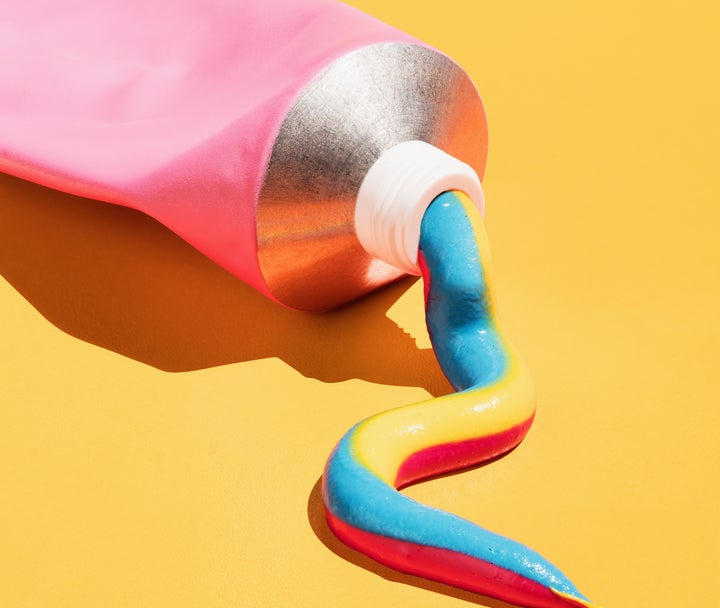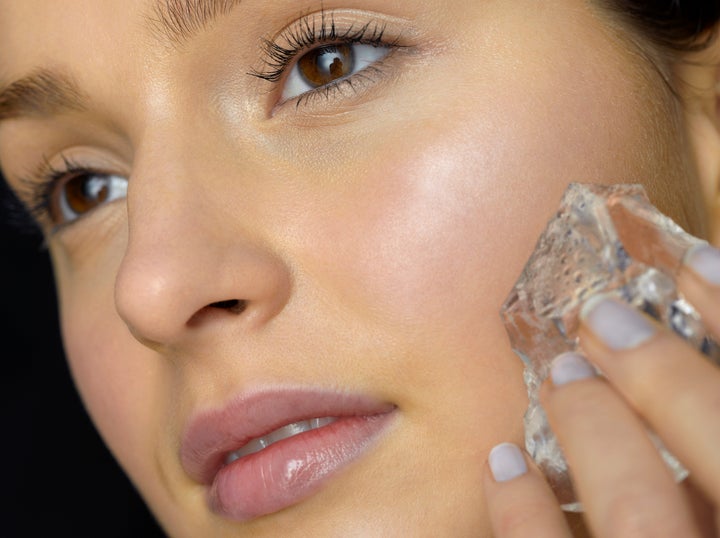
TikTok may seem like a font of amazing skin care advice and inspiration, but medical professionals don’t always think so.
“I think it is important to always be cautious about what is said on TikTok and always speak with a professional or a board-certified dermatologist when it comes to your own personal skin regimen to ensure what you are using is good for your skin,” New York City board-certified dermatologist Dr. Marisa Garshick told HuffPost. “It is important to remember that just because you see it on TikTok, doesn’t mean it is necessarily safe and doesn’t mean it is necessarily good for you.”
This is particularly true of acne treatments. HuffPost asked Garshick and other dermatologists to share the acne hacks and fads they’ve observed on TikTok but do not recommend trying.
From skin icing to the “potato hack,” below are seven acne treatment trends you’re better off avoiding.
1. Toothpaste as a spot treatment
“The idea of putting toothpaste on acne as a spot treatment has been around for a long time, based on the antibacterial properties related to an ingredient previously used in toothpastes called triclosan and the drying properties related to baking soda and hydrogen peroxide,” Garshick said. “But it is important to remember that this can lead to irritation and dryness of the skin, especially when applied all over, as some on TikTok are doing.”
Most commercially available toothpastes no longer contain triclosan, and even if they did, dermatologists still point to the potential for irritation and even chemical burns.
“We have lots of great acne-fighting ingredients such as salicylic acid, benzoyl peroxide, retinoids and more, that we don’t need to rely on toothpaste for our acne anymore, no matter how convenient it may be,” Garshick said.
2. The ‘potato hack’
Another TikTok trick that went viral is the “potato hack,” in which people put pieces of raw potato over their pimples to make them go away.
“Some justify this [by saying] potato can contain small amounts of salicylic acid, but this raw potato application stunt to severe acne is just silly and ineffective,” said Dr. Melanie D. Palm, a board-certified dermatologist and medical director at the Art of Skin MD in Southern California.
“Why would someone apply a raw vegetable to the face when effective acne treatments exist over the counter (retinoids, benzoyl peroxide and salicylic acid) that have proven effectiveness AND safety approved by the Food and Drug Administration?” she asked.
She added that potato allergies are rare but exist and can lead to severe symptoms, as can cross-reactive allergic reactions to potato due to other known allergens like latex and birch pollen.
3. Skin icing
“Using ice on pimples and to de-puff your face is not dangerous as long as it’s done properly,” said Dr. Annie Gonzalez, a board-certified dermatologist in Miami. “Very often, pimples or cysts are inflamed. Ice brings down inflammation.”

However, she cautioned against applying an ice cube to your bare skin. Instead, wrap it in a washcloth and go over the area in a light, continuous motion. Do not rub. And follow that step with a doctor-recommended acne treatment like salicylic acid, she added.
Dr. Sheila Farhang, a board-certified dermatologist based in Arizona, echoed Gonzalez’s advice not to apply ice directly to your face.
“Direct ice can damage the skin ― think microscopic frostbite,” she explained. “For puffiness, I recommend putting a moisturizer in a skin fridge, so it is cool but not too cold, as this can change the formulation. Rollers made of rose quartz or jade are inherently cooling stones so this is also a great alternative.”
Farhang also warned against skin icing as a treatment for melasma.
“I literally cringe when I see people recommending icing their skin to help with their melasma ― this can actually worsen it, given that when it comes to melasma, anything that causes redness or irritation will turn brown,” she said. “SPF is way more important!”
4. Covering your face with Band-Aids
Another popular acne treatment trend on TikTok is covering your face with Band-Aids.
“This is literally a Band-Aid fix!” Palm said. “It is ineffective and simply occludes an inflammatory acne lesion from the surrounding environment. This would be effective for an individual that picks every single acne lesion, but this Band-Aid hack in no way is therapeutic in improving active acne.”
She added that the skin usually tolerates hydrogel bandages fairly well, but there’s still a potential for allergic reactions. And if the Band-Aids are left on too long without cleansing, secondary skin infections could develop.
5. Drinking chlorophyll water
Consuming liquid chlorophyll to clear up acne became popular in the world of skin care Twitter earlier this year, but dermatologists are hesitant to recommend it given the lack of scientific research on its effectiveness in treating acne.
“Chlorophyll is safe for human consumption, but the benefits are not proven. It’s probably a better idea to get chlorophyll from eating green vegetables,” said New York City dermatologist Dr. Hadley King. “There are some trials that have shown that topical chlorophyll can help reduce acne because of its anti-inflammatory and anti-bacterial properties. But we don’t yet have data about oral chlorophyll’s effects on acne.”
So while you may find some benefits from drinking chlorophyll, you may experience even more from eating a balanced diet high in vegetables, which has other positive effects on the body as a whole. And don’t expect it to clear your severe cystic acne.
6. Applying lemon juice to reduce scarring
Using lemon juice to lighten or remove acne scars may seem like an innocuous trick, but dermatologists beg to differ.
“As we are all wonderfully different, a skin care routine or treatment that is great for one person may not be the best option or could even be harmful to someone else,” said Dr. James Ralston, a dermatologist based in Texas. “For example, lemon juice is highly acidic and when applied to the skin can cause irritation, especially for those with sensitive skin. It can also cause discoloration, especially for those with darker skin types.”
Just because something seems “all natural” or looks like a quick fix on TikTok doesn’t mean it’s advisable to use on your skin.
“Applying a strong citrus acid to your face, such as lemon or lime juice, can create a phototoxic reaction when you go in the sun leading to blistering, burns and hyperpigmentation,” said Dr. Brian Hibler of Schweiger Dermatology Group in New York City.
7. Spraying salt water
Spraying your face with salt water to treat acne is generally harmless, but there’s no real data to support its effectiveness, noted King.
“The salt could help to dry up pimples, and there could be a mild anti-inflammatory effect. But we have much better, science-backed options!” she explained.
“Some of the TikTok people claim that sea water balances skin pH and kills bacteria, but these claims aren’t really true,” King continued. “Acne-prone skin has an alkaline pH and sea water also has an alkaline pH, around 8. You’d want to use an acidic pH like salicylic acid or glycolic acid to be helpful. And although sea salt water does have antimicrobial properties, they’re not really strong enough to squash acne.”
She also noted that trying this hack could lead a person to put off seeing a board-certified dermatologist to start a more science-backed treatment ― a delay that could result in more acne, discoloration and scarring.